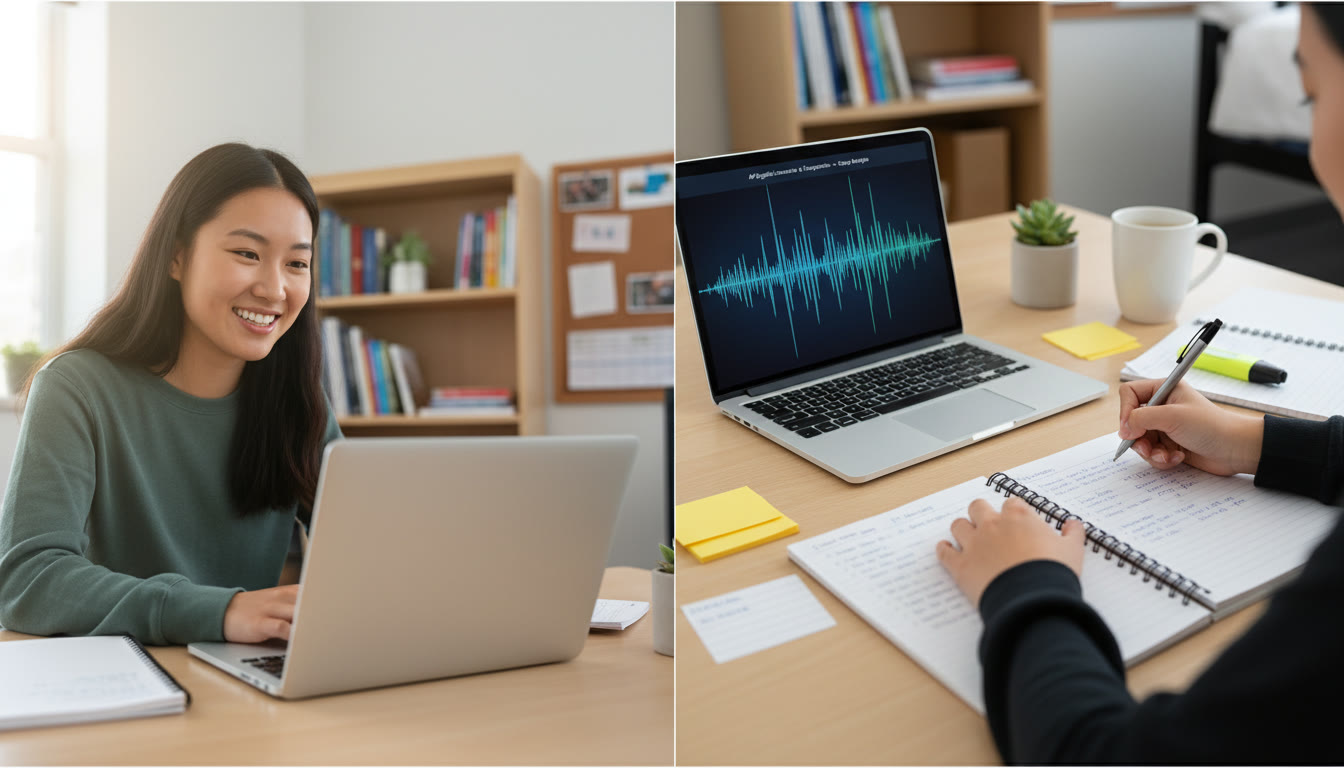Why Pronunciation and Prosody Matter for AP Students
If you’re preparing for AP exams like AP English Language, AP Spanish, or any AP task that asks you to present, explain, or speak in class, pronunciation and prosody are more than niceties — they’re tools that help your ideas land. Pronunciation ensures your words are understood; prosody — the rhythm, stress, and intonation of speech — shapes meaning, signals emphasis, and makes listening effortless. In short, clearer pronunciation + smarter prosody = more persuasive arguments, higher clarity on spoken responses, and a confident presence during oral assessments.
What This Guide Offers
In this blog you’ll find a practical, research-informed routine to record yourself, analyze your speech, and improve consistently. You’ll get step-by-step practice plans, sample exercises, a simple rubric for self-evaluation, and a weekly schedule you can adapt. Real-world examples, comparison points, and a data table to track progress are included. I’ll also explain how targeted support — like Sparkl’s personalized tutoring — can amplify results, especially when you need tailored feedback and a plan designed for your voice and goals.

Core Concepts: Pronunciation vs. Prosody
Before we build routines, let’s name the pieces clearly:
- Pronunciation — how accurately you form sounds: vowels, consonants, syllable stress, and connected speech (linking words and reducing sounds).
- Prosody — the musicality of speech: pitch (intonation), loudness (stress and emphasis), tempo (speed), and rhythm (how the sentence is chunked).
Think of pronunciation as the letters of the musical score and prosody as the conductor’s gestures. Both are essential to deliver a performance that communicates clearly and persuasively.
Why Recording Works Better Than Just Speaking
It’s tempting to practice aloud and assume improvement. But recording unlocks objective insights you can’t get in the moment. When you record you can:
- Hear patterns you miss when speaking (repeated mispronunciations, unclear endings, monotone tendencies).
- Compare different takes and choose the best elements.
- Quantify progress by tracking metrics over weeks.
- Share recordings with a tutor or peer for focused feedback.
What to Record
Your recordings should be purposeful, varied, and measurable. Aim for three types of recordings each week:
- Warm-up drills (2–4 minutes) — focused on articulation and breath.
- Micro-practices (3–6 minutes) — short prompts or quotations from AP-style sources practiced for clarity and prosody.
- Full responses (5–8 minutes) — simulated spoken responses or presentations, recorded as if in exam or class conditions.
A Practical 6-Week Recording Routine
This structured routine balances technical work with contextual practice. Record at least three times per week, ideally on alternating days (e.g., Monday, Wednesday, Saturday).
Week-by-Week Plan
- Weeks 1–2: Foundations
- Focus: clear articulation, word endings, and basic intonation patterns.
- Activities: IPA-inspired sound drills (vowels/consonants), minimal pairs, short reading aloud with exaggerated stress.
- Weeks 3–4: Rhythm and Chunking
- Focus: sentence-level prosody, pausing, and logical chunking.
- Activities: read complex sentences and mark where you naturally pause, practice phrasing to match meaning, and record micro-responses.
- Weeks 5–6: Performance and Polishing
- Focus: exam-like delivery, controlled pace, and expressive intonation for emphasis.
- Activities: full simulated responses under time constraints, targeted corrections from earlier recordings, and peer/tutor feedback.
Daily Session Template (30–40 minutes)
Consistency matters more than duration. A balanced session trains body, ear, and cognition simultaneously.
- 5 minutes — Warm-up: breathing, lip trills, tongue twisters.
- 10 minutes — Drill work: targeted sounds and stress patterns; use slow-to-fast repetition.
- 10 minutes — Context practice: read an AP-style paragraph aloud, focusing on chunking and emphasis.
- 10–15 minutes — Record & review: one full take of a prompt, then immediate playback and note-taking.
Simple Warm-up Examples
- Lip trills: blow air through closed lips while voicing (helps breath control).
- Tongue twisters: “She sells sea shells…”—start slow, increase speed.
- Humming into vowel sounds: hum then glide to /a/ /e/ /i/ /o/ /u/ to feel resonance.
How to Structure Your Recordings
Use a consistent format for each recording so comparisons are meaningful. A simple template:
- Title: Date, Prompt/Drill, Duration
- Context: e.g., “AP Rhetoric prompt — 5-minute spoken response”
- Objective: e.g., “Improve clause linking and sentence-final clarity”
- Take 1–3: record multiple takes, label them, and select the best for analysis
Self-Review Checklist (5 items)
- Are word endings audible? (e.g., past tense -ed, plural -s)
- Is stress placed on the correct syllable for multisyllabic words?
- Is intonation varied where meaning changes (questions, emphasis)?
- Are pauses used to mark ideas, not just to breathe?
- Is pace appropriate — not so fast that clarity suffers, not so slow that engagement drops?
Example Exercises and Scripts
Practice with AP-relevant material: rhetorical passages, argumentative claims, and academic summaries. Below are examples you can record.
Exercise 1 — Chunked Reading (Prosody Focus)
Take a short paragraph from an AP-style passage. Mark natural idea units with slashes. Read slowly, pausing at each slash, then record. Example pattern:
“Renewable energy has grown rapidly / over the last decade, / driven by falling costs / and improved technologies. / Yet transition remains uneven / across regions and sectors.”
Exercise 2 — Contrastive Stress (Meaning)
Practice the same sentence with different emphases to explore how prosody changes meaning. Record three versions and compare.
- “I never said she stole the money.” (emphasize different words each time)
- Note how stress shifts the implied accusation or denial.
Exercise 3 — Timed AP Response
Choose a prompt and give a 4–6 minute recorded response. Treat it like an in-class speaking task. After recording, review for structure, clarity, and prosody.
Using a Simple Rubric to Track Improvement
Below is a compact rubric you can use to score each recording on a 1–5 scale. Record scores in a tracking table and watch trends, not just individual numbers.
| Criterion | 1 | 3 | 5 |
|---|---|---|---|
| Pronunciation Clarity | Frequent unclear words | Occasional errors but understandable | Clear and accurate articulation |
| Prosody & Intonation | Monotone or confusing pitch | Some variation, uneven delivery | Expressive and meaning-enhancing prosody |
| Pace & Pausing | Too fast or too slow, poor pauses | Generally good, occasional rushes | Natural tempo, effective pauses |
| Overall Communicative Effect | Listener struggles to follow | Listener mostly follows message | Listener engaged and persuaded |
Sample Weekly Tracking Table
Log the date, prompt type, duration, and rubric scores. Use this to spot plateaus and breakthroughs.
| Date | Prompt/Drill | Duration | Pronunciation (1–5) | Prosody (1–5) | Notes |
|---|---|---|---|---|---|
| 2025-10-01 | Timed AP Response | 5:00 | 3 | 2 | Rushed ending; unclear past tense |
| 2025-10-04 | Chunked Reading | 3:30 | 4 | 3 | Better pauses; work on pitch variety |
Analyzing Your Recordings: What to Listen For
Make notes while you listen. A few things to prioritize:
- Consistent trouble sounds: are there consonants or vowels you regularly reduce or drop?
- Sentence endings: final consonants and inflections often get lost; correct them deliberately.
- Monotone zones: which parts of your recording sound flat? Usually long lists or explanations—mark these and try to add pitch variation.
- Gaps vs. pauses: is silence meaningful or is it hesitation? Replace filler with thoughtful silence.
Quick Fixes for Common Problems
Don’t get bogged down in perfection. Small adjustments compound quickly.
- Mumbled endings: exaggerate final consonants in practice — then dial back to naturalness.
- Monotone: mark key words in your script and practice lifting pitch on focus words.
- Too fast: practice with a metronome or read one short sentence per breath cycle.
- Breathiness or lack of projection: practice diaphragmatic breathing and forward placement of voice.
Bringing Feedback Into the Loop
Recording alone gets you far. Feedback accelerates improvement. Try these options:
- Exchange recordings with a study partner for peer critique.
- Use voice-analysis apps for waveform and pitch visualization as a mirror to your ear.
- Work with a coach or tutor for targeted corrections. Sparkl’s personalized tutoring is an excellent fit here — experts provide 1-on-1 guidance, tailored study plans, and actionable feedback based on your recordings, plus AI-driven insights to highlight recurring patterns.
Example Progress Scenario
Meet Lina, an AP Spanish student anxious about oral exams. Week 1 recordings show weak sentence-final consonants and monotone delivery. Her weekly routine followed the plan above and included two tutor reviews with Sparkl for focused help. By Week 4 Lina’s recordings show clearer endings, better phrase chunking, and dynamic intonation in argumentative responses. Her rubric scores moved from 2–3 to 4–5 in key areas — and importantly, her confidence rose because she could hear the progress.
Tools and Tech: What You Need
High-end gear isn’t required. Here’s a stack that works for most students:
- Smartphone with a simple voice-recording app (most built-in recorders are fine).
- Optional: an inexpensive USB condenser microphone for clearer capture if you plan frequent recordings.
- Earbuds or headphones for critical listening.
- A simple note app or spreadsheet to log scores and observations.
How to Use Technology Wisely
Don’t get lost tweaking settings. Keep recordings consistent (same room, mic placement, and distance) so comparisons are valid. Label files with date, prompt, and take number. If you share recordings with a tutor, include the objective and the specific moments you want feedback on.
Staying Motivated: Micro Wins and Milestones
Improvement in spoken performance can feel slow because we often compare early days to an ideal. Instead, celebrate micro wins:
- First time you can hear a particular consonant clearly.
- Moment you naturally vary pitch to highlight an argument.
- A full timed response where you felt neither rushed nor monotone.
Document those moments in your notes. They make the path forward visible.
Final Checklist Before an AP Oral or Presentation
- Do a 5-minute warm-up before the exam to center breath and articulation.
- Run a mental outline of your response and mark where to pause and emphasize.
- Keep a water bottle nearby; sip if you feel dry but avoid gulping during speaking.
- Remember: clarity trumps theatricality. Aim to be understood first, then expressive.

How Sparkl’s Personalized Tutoring Can Fit Naturally Into This Routine
If you want accelerated progress, professional feedback is a multiplier. Sparkl offers 1-on-1 guidance that integrates directly with a recording routine: expert tutors listen to your takes, provide line-by-line corrections, and help build a tailored study plan that targets your weakest phonemes, typical prosody errors, and exam-specific delivery. The combination of human expertise and AI-driven insights helps pinpoint recurring patterns you might miss when self-reviewing. Use that feedback to refine your weekly rubric and to get homework that’s laser-focused on what actually moves your scores.
Closing Thoughts
Recording practice is an investment. It turns fleeting impressions into documented progress and trains both your ears and your voice. With a consistent routine, deliberate drills, and focused feedback (whether from a peer or a tutor at Sparkl), even small daily efforts compound into measurable improvement. Remember: clarity is persuasive; prosody is expressive. Together they transform good ideas into memorable performances.
Takeaway Action Plan (Your Next 7 Days)
- Day 1: Establish baseline — record one timed response and score it with the rubric.
- Day 2: Do warm-ups and 3 targeted sound drills; record one micro-practice.
- Day 3: Chunked reading and prosody work; record and compare to Day 2.
- Day 4: Rest or light review — listen to recordings and note patterns.
- Day 5: Timed response with a focus (e.g., final consonants) and log rubric scores.
- Day 6: Seek feedback — exchange recordings with a peer or upload to a tutor platform like Sparkl for targeted review.
- Day 7: Reflect, adjust your next week’s objective based on notes, and repeat.
Start small, record honestly, review critically, and reward yourself for progress. Your voice is a skill — train it like any other, and it will serve you across AP exams, classroom presentations, and beyond.
























No Comments
Leave a comment Cancel